1.4: Using Variables to Solve Equations
- Page ID
- 108488
By the end of this section, you will be able to:
- Verify a solution of an equation
- Solve equations using the Subtraction and Addition Properties of Equality
- Solve equations that require simplification
- Translate to an equation and solve
- Translate and solve applications
- Compute \(2\cdot 5-3\)
- Evaluate \(x+4\) when \(x=−3\).
- Evaluate \(15−y\) when \(y=−5\).
- Answer
-
- 7
- 1
- 20
Verify a Solution of an Equation
Solving an equation is like discovering the answer to a puzzle. The purpose in solving an equation is to find the value or values of the variable that make each side of the equation the same – so that we end up with a true statement. Any value of the variable that makes the equation true is called a solution to the equation. It is the answer to the puzzle!
A solution of an equation is a value of a variable that makes a true statement when substituted into the equation.
- Substitute the number in for the variable in the equation.
- Simplify the expressions on both sides of the equation.
- Determine whether the resulting equation is true (the left side is equal to the right side)
- If it is true, the number is a solution.
- If it is not true, the number is not a solution.
Determine whether \(x = \frac{3}{2}\) is a solution of \(4x−2=2x+1\).
- Answer
-
Since a solution to an equation is a value of the variable that makes the equation true, begin by substituting the value of the solution for the variable.
Solution to the example. \(4 x-2=2 x+1\) 
\(4\left(\color{red}\frac{3}{2}\color{black}\right)-2 \stackrel{?}{=} 2\left(\color{red}\frac{3}{2}\color{black}\right)+1\) Multiply. \(6-2 \stackrel{?}{=} 3+1\) Subtract. \(4=4 \checkmark \) Since \(x = \frac{3}{2}\) results in a true equation (4 is in fact equal to 4), \(\frac{3}{2}\) is a solution to the equation \(4x−2=2x+1\).
Is \(y = \frac{4}{3}\) a solution of \(9y+2=6y+3\)?
- Answer
-
no
Is \(y = \frac{7}{5}\) a solution of \(5y+3=10y-4\)?
- Answer
-
yes
Solve Equations Using the Subtraction and Addition Properties of Equality
We are going to use a model to clarify the process of solving an equation. An envelope represents the variable – since its contents are unknown – and each counter represents one. We will set out one envelope and some counters on our workspace, as shown in Figure \(\PageIndex{1}\). Both sides of the workspace have the same number of counters, but some counters are “hidden” in the envelope. Can you tell how many counters are in the envelope?
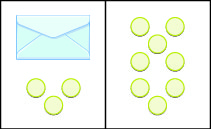
What are you thinking? What steps are you taking in your mind to figure out how many counters are in the envelope?
Perhaps you are thinking: “I need to remove the 3 counters at the bottom left to get the envelope by itself. The 3 counters on the left can be matched with 3 on the right and so I can take them away from both sides. That leaves five on the right—so there must be 5 counters in the envelope.” See Figure \(\PageIndex{2}\) for an illustration of this process.

What algebraic equation would match this situation? In Figure \(\PageIndex{3}\) each side of the workspace represents an expression and the center line takes the place of the equal sign. We will call the contents of the envelope x.
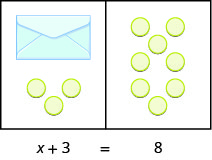
Let’s write algebraically the steps we took to discover how many counters were in the envelope:
 |
|
|---|---|
| First, we took away three from each side. |  |
| Then we were left with five. |  |
Check:
Five in the envelope plus three more does equal eight!
\[5+3=8\]
Our model has given us an idea of what we need to do to solve one kind of equation. The goal is to isolate the variable by itself on one side of the equation. To solve equations such as these mathematically, we use the Subtraction Property of Equality.
For any numbers a, b, and c,
\[\begin{array} {ll} {\text{If}} &{a = b} \\ {\text{then}} &{a - c = b - c} \end{array}\]
When you subtract the same quantity from both sides of an equation, you still have equality.
Let’s see how to use this property to solve an equation. Remember, the goal is to isolate the variable on one side of the equation. And we check our solutions by substituting the value into the equation to make sure we have a true statement.
Solve: \(y+37=−13\).
- Answer
-
To get y by itself, we will undo the addition of 37 by using the Subtraction Property of Equality.
Solution to the example. 
Subtract 37 from each side to ‘undo’ the addition. 
Simplify. 
Check: 
Substitute \(y=−50\) 

Since y=−50 makes y+37=−13 a true statement, we have the solution to this equation.
Solve: \(x+19=−27\).
- Answer
-
\(x=−46\)
Solve: \(x+16=−34\).
- Answer
-
\(x=−50\)
What happens when an equation has a number subtracted from the variable, as in the equation \(x−5=8\)? We use another property of equations to solve equations where a number is subtracted from the variable. We want to isolate the variable, so to ‘undo’ the subtraction we will add the number to both sides. We use the Addition Property of Equality.
For any numbers a, b, and c,
\[\begin{array} {ll} {\text{If}} &{a = b} \\ {\text{then}} &{a + c = b + c} \end{array}\]
When you add the same quantity from both sides of an equation, you still have equality.
In Exercise \(\PageIndex{4}\), 37 was added to the y and so we subtracted 37 to ‘undo’ the addition. In Exercise \(\PageIndex{7}\), we will need to ‘undo’ subtraction by using the Addition Property of Equality.
Solve: \(a−28=−37\).
- Answer
-
Solution to the example. 
Add 28 to each side to ‘undo’ the subtraction. 
Simplify. 
Check: 
Substitute \(a=−9\) 

The solution to \(a−28=−37\) is \(a=−9\).
Solve: \(n−61=−75\).
- Answer
-
\(n=−14\)
Solve: \(p−41=−73\).
- Answer
-
\(p=−32\)
Solve: \(x - \frac{5}{8} = \frac{3}{4}\)
- Answer
-
Solution to the example. 
Use the Addition Property of Equality. 
Find the LCD to add the fractions on the right. \(x-\frac{5}{8}+\frac{5}{8}=\frac{6}{8}+\frac{5}{8}\) Simplify. \(x=\frac{11}{8}\) Check: 
Substitute \(x= \frac{11}{8}\) 
Subtract. 
Simplify. 
The solution to \(x - \frac{5}{8} = \frac{3}{4}\) is \(x= \frac{11}{8}\).
Solve: \(p−\frac{2}{3}=\frac{5}{6}\).
- Answer
-
\(p = \frac{9}{6} =\frac{3}{2}\)
Solve: \(q−\frac{1}{2}=\frac{5}{6}\).
- Answer
-
\(q =\frac{4}{3}\)
The next example will be an equation with decimals.
Solve: \(n−0.63=−4.2\).
- Answer
-
Solution to the example. \(n-0.63=-4.2\) Use the Addition Property of Equality. 
Add. \(n=-3.57\) Check: \(n=-3.57\) Let \(n=−3.57\). 

Solve: \(b−0.47=−2.1\).
- Answer
-
\(b=−1.63\)
Solve: \(c−0.93=−4.6\).
- Answer
-
\(c=−3.67\)
Solve Equations That Require Simplification
In the previous examples, we were able to isolate the variable with just one operation. Most of the equations we encounter in algebra will take more steps to solve. Usually, we will need to simplify one or both sides of an equation before using the Subtraction or Addition Properties of Equality.
You should always simplify as much as possible before you try to isolate the variable. Remember that to simplify an expression means to do all the operations in the expression. Simplify one side of the equation at a time. Note that simplification is different from the process used to solve an equation in which we apply an operation to both sides.
Solve: \(9x−5−8x−6=7\).
- Answer
-



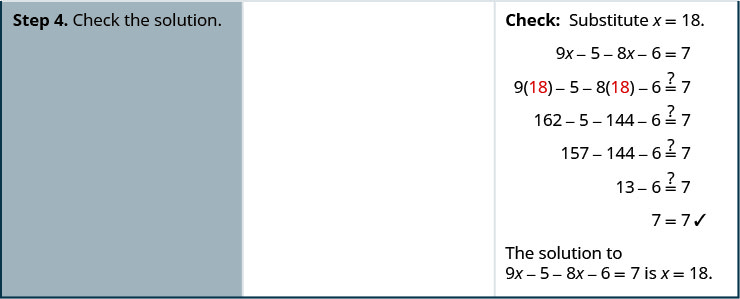
Solve: \(8y−4−7y−7=4\).
- Answer
-
\(y=15\)
Solve: \(6z+5−5z−4=3\).
- Answer
-
\(z=2\)
Solve: 5(n−4)−4n=−8.
- Answer
-
We simplify both sides of the equation as much as possible before we try to isolate the variable.
Solution to the example. \(5(n-4)-4 n=-8\)
Distribute on the left. \(5 n-20-4 n=-8\) Use the Commutative Property to rearrange terms. \(5 n-4 n-20=-8\) Combine like terms. \(n-20=-8\) Each side is as simplified as possible. Next, isolate n. Undo subtraction by using the Addition Property of Equality. \(n-20 \; \color{red}{+ 20} \;\color{black}{=-8}\; \color{red}{+20}\) Add. \(n=12\) Check. Substitute n=12.
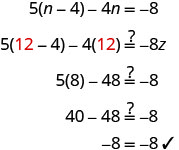
The solution to \(5(n−4)−4n=−8\) is \(n=12\).
Solve: \(5(p−3)−4p=−10\).
- Answer
-
\(p=5\)
Solve: \(4(q+2)−3q=−8\).
- Answer
-
\(q=−16\)
Solve: \(3(2y−1)−5y=2(y+1)−2(y+3)\).
- Answer
-
We simplify both sides of the equation before we isolate the variable.
Solution to the example. \(3(2 y-1)-5 y=2(y+1)-2(y+3)\) Distribute on both sides. \(6 y-3-5 y=2 y+2-2 y-6\) Use the Commutative Property of Addition. \(6 y-5 y-3=2 y-2 y+2-6\) Combine like terms. \(y-3=-4\) Each side is as simplified as possible. Next, isolate y. Undo subtraction by using the Addition Property of Equality. \(y-3 \color{red} + 3 \color{black} = -4 \color{red} +3\) Add. \(y=-1\) Check. Let y=−1.
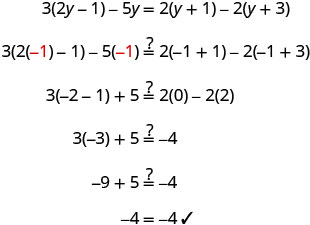
The solution to \(3(2y−1)−5y=2(y+1)−2(y+3)3(2y−1)−5y=2(y+1)−2(y+3)\) is \(y=−1\).
Solve: \(4(2h−3)−7h=6(h−2)−6(h−1)\).
- Answer
-
\(h = 6\)
Solve: \(2(5x+2)−9x=3(x−2)−3(x−4)\).
- Answer
-
\(x=2\)
Solve Equations Using the Division and Multiplication Properties of Equality
You may have noticed that all of the equations we have solved so far have been of the form \(x+a=b\) or \(x−a=b\). We were able to isolate the variable by adding or subtracting the constant term on the side of the equation with the variable. Now we will see how to solve equations that have a variable multiplied by a constant and so will require division to isolate the variable.
Let’s look at our puzzle again with the envelopes and counters in Figure \(\PageIndex{1}\).
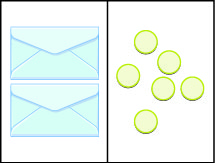
In the illustration there are two identical envelopes that contain the same number of counters. Remember, the left side of the workspace must equal the right side, but the counters on the left side are “hidden” in the envelopes. So how many counters are in each envelope?
How do we determine the number? We have to separate the counters on the right side into two groups of the same size to correspond with the two envelopes on the left side. The 6 counters divided into 2 equal groups gives 3 counters in each group (since \(6\div 2=3\)).
What equation models the situation shown in Figure \(\PageIndex{2}\)? There are two envelopes, and each contains xx counters. Together, the two envelopes must contain a total of 6 counters.
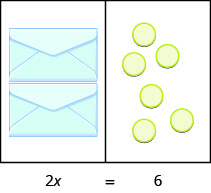
 |
|
|---|---|
| If we divide both sides of the equation by 2, as we did with the envelopes and counters, |  |
| we get: |  |
We found that each envelope contains 3 counters. Does this check? We know \(2\cdot 3=6\), so it works! Three counters in each of two envelopes does equal six!
This example leads to the Division Property of Equality.
For any numbers a, b, and c, and \(c\neq 0\),
\[\begin{array} {llll} {\text { If }} &{a} &{=} &{b} \\ {\text {then}} & {\frac { a } { c }} &{=} &{\frac { b } { c }} \end{array}\]
When you divide both sides of an equation by any non-zero number, you still have equality.
The goal in solving an equation is to ‘undo’ the operation on the variable. In the next example, the variable is multiplied by 5, so we will divide both sides by 5 to ‘undo’ the multiplication.
Solve: \(5x=−27\).
- Answer
-
Solution to the example. To isolate x, “undo” the multiplication by 5. 
Divide to ‘undo’ the multiplication. 
Simplify. 
Check: 
Substitute \(-\frac{27}{5}\) for x. 

Since this is a true statement, \(x = -\frac{27}{5}\)
is the solution to \(5x=−27\).
Solve: \(3y=−41\).
- Answer
-
\(y = -\frac{41}{3}\)
Solve: \(4z=−55\).
- Answer
-
\(y = -\frac{55}{4}\)
Consider the equation \(\frac{x}{4} = 3\). We want to know what number divided by 4 gives 3. So to “undo” the division, we will need to multiply by 4. The Multiplication Property of Equality will allow us to do this. This property says that if we start with two equal quantities and multiply both by the same number, the results are equal.
For any numbers a, b, and c,
\[\begin{array} {llll} {\text {If}} &{a} & {=} &{b} \\ {\text {then}} &{a c} &{=} &{b c} \end{array}\]
If you multiply both sides of an equation by the same number, you still have equality.
Solve: \(\frac{y}{-7} = -14\)
- Answer
-
Here y is divided by −7. We must multiply by −7 to isolate y.
Solution to the example. 
Multiply both sides by −7. 
Multiply. 
Simplify. 
Check: \(\frac{y}{-7} = -14\) Substitute y=98. 
Divide. 
Solve: \(\frac{a}{-7} = -42\)
- Answer
-
\(a = 294\)
Solve: \(\frac{b}{-6} = -24\)
- Answer
-
\(b = 144\)
Solve: \(-n = 9\)
- Answer
-
Solution to the example. 
Remember −n is equivalent to −1n. 
Divide both sides by −1. 
Divide. 
Notice that there are two other ways to solve −n=9. We can also solve this equation by multiplying both sides by −1 and also by taking the opposite of both sides. Check: 
Substitute n=−9. 
Simplify. 
Solve: \(−k=8\).
- Answer
-
\(k = -8\)
Solve: \(−g=3\).
- Answer
-
\(g = -3\)
Solve: \(\frac{3}{4}x = 12\)
- Answer
-
Since the product of a number and its reciprocal is 1, our strategy will be to isolate x by multiplying by the reciprocal of \(\frac{3}{4}\).
Solution to the example. 
Multiply by the reciprocal of \(\frac{3}{4}\). 
Reciprocals multiply to 1. 
Multiply. 
Notice that we could have divided both sides of the equation \(\frac{3}{4}x = 12\) by \(\frac{3}{4}\) to isolate x. While this would work, most people would find multiplying by the reciprocal easier. Check: 
Substitute \(x=16\). 

Solve: \(\frac{2}{5}n=14\).
- Answer
-
\(n = 35\)
Solve: \(\frac{5}{6}y=15\).
- Answer
-
\(y = 18\)
In the next example, all the variable terms are on the right side of the equation. As always, our goal in solving the equation is to isolate the variable.
Solve: \(\frac{8}{15} = -\frac{4}{5}x\)
- Answer
-
Solution to the example. 
Multiply by the reciprocal of \(-\frac{4}{5}\). 
Reciprocals multiply to 1. 
Multiply. 
Check: 
Let \(x = -\frac{2}{3}\). 

Solve: \(\frac{9}{25} = -\frac{4}{5}z\)
- Answer
-
\(z = - \frac{9}{20}\)
\(\frac{5}{6} = -\frac{8}{3}r\)
- Answer
-
\(r = -\frac{5}{16}\)
Solve Equations That Require Simplification
Many equations start out more complicated than the ones we have been working with.
With these more complicated equations the first step is to simplify both sides of the equation as much as possible. This usually involves combining like terms or using the distributive property.
Solve: \(14−23=12y−4y−5y\).
- Answer
-
Begin by simplifying each side of the equation.
Solution to the example. 
Simplify each side. 
Divide both sides by 3 to isolate y. 
Divide. 
Check: 
Substitute \(y=−3\). 


Solve: \(18−27=15c−9c−3c\).
- Answer
-
\(c=−3\)
Solve: \(18−22=12x−x−4x\).
- Answer
-
\(x = -\frac{4}{7}\)
Solve: \(−4(a−3)−7=25\).
- Answer
-
Here we will simplify each side of the equation by using the distributive property first.
Solution to the example. 
Distribute. 
Simplify. 
Simplify. 
Divide both sides by \(-4\) to isolate a. 
Divide. 
Check: 
Substitute \(a = -5\) 



Solve: \(−4(q−2)−8=24\).
- Answer
-
\(q=−6\)
Solve: \(−6(r−2)−12=30\).
- Answer
-
\(r=−5\)
Now we have covered all four properties of equality—subtraction, addition, division, and multiplication. We’ll list them all together here for easy reference.
When you add, subtract, multiply, or divide the same quantity from both sides of an equation, you still have equality.
\[\begin{array} {ll} {\textbf {Subtraction Property of Equality}} &{\textbf{Addition Property of Equality}} \\
{\text{For any real numbers a, b, and c,}} &{\text{For any real numbers a, b, and c,}}
\\ {\text{if }a = b,} &{\text{if }a = b,}
\\ {\text{then }a - c = b - c} &{\text{then }a + c = b + c}
\\ {\textbf {Divition Property of Equality}} &{\textbf{Multiplication Property of Equality}} \\
{\text{For any real numbers a, b, and c,}} &{\text{For any real numbers a, b, and c,}}
\\ {\text{if }a = b,} &{\text{if }a = b,}
\\ {\text{then }a - c = b - c} &{\text{then }a + c = b + c}
\end{array}\]
When you add, subtract, multiply, or divide the same quantity from both sides of an equation, you still have equality.
Key Concepts
- To Determine Whether a Number is a Solution to an Equation
- Substitute the number in for the variable in the equation.
- Simplify the expressions on both sides of the equation.
- Determine whether the resulting statement is true.
- If it is true, the number is a solution.
- If it is not true, the number is not a solution.
- Addition Property of Equality
- For any numbers a, b, and c, if a=b, then a+c=b+c.
- Subtraction Property of Equality
- For any numbers a, b, and c, if a=b, then a−c=b−c.
- The Division Property of Equality—For any numbers a, b, and c, and \(c\neq 0\), if \(a=b\), then \(\frac{a}{c} = \frac{b}{c}\).
When you divide both sides of an equation by any non-zero number, you still have equality. - The Multiplication Property of Equality—For any numbers a, b, and c, if \(a=b\), then \(ac = bc\).
If you multiply both sides of an equation by the same number, you still have equality.
Glossary
- solution of an equation
- A solution of an equation is a value of a variable that makes a true statement when substituted into the equation.

